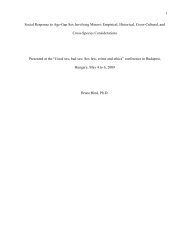Infant and Child Sexuality: A Sociological Perspective - Ipce
Infant and Child Sexuality: A Sociological Perspective - Ipce
Infant and Child Sexuality: A Sociological Perspective - Ipce
Create successful ePaper yourself
Turn your PDF publications into a flip-book with our unique Google optimized e-Paper software.
pervasive aspect of one’s total personality, the sum total of one’s<br />
feelings <strong>and</strong> behavior not only as a sexual being, but as a male or female,”<br />
(Kirkendal <strong>and</strong> Rubin, 1969) the answer has to be no. The infant<br />
has an emerging but an only slightly developed self identity, is not<br />
well-coordinated or organized, has only the most rudimentary underst<strong>and</strong>ing<br />
of gender roles, <strong>and</strong> does not possess the erotic imagery of an<br />
adult. Socially-appropriate gender roles--male <strong>and</strong> female--come later<br />
as gender roles are learned. This learning begins in infancy <strong>and</strong> continues<br />
through childhood <strong>and</strong> beyond. The richness of erotic imagery<br />
available to the adult comes only after numerous <strong>and</strong> varied direct <strong>and</strong><br />
vicarious experiences.<br />
Summary<br />
The three major theories of human sexual development are the hormone<br />
theory, the psychoanalytic theory <strong>and</strong> the social or social learning<br />
theory. Each theory focuses on different aspects of human<br />
development, <strong>and</strong>, therefore, each contributes to the underst<strong>and</strong>ing of<br />
human sexuality. This book brings together what is known concerning the<br />
sociology of infant sexuality to date, adds new data, <strong>and</strong> provides a<br />
catalyst for needed socio-sexual research.<br />
The infant is a creature with potential. Development of that potential<br />
occurs through experience. The human offspring possesses somatosensory<br />
response capacity from early in the fetal stage <strong>and</strong> on. Although<br />
the mouth is the chief pleasure zone of the infant during the<br />
first year, responsiveness to external stimulation of other parts of<br />
the body, including the genitalia, is apparent.<br />
The infant demonstrates a capacity to interact with others from the<br />
first year of life. Early encounters of infant <strong>and</strong> mother contribute to<br />
sensory <strong>and</strong> affectional awakening of the infant. The infant is not only<br />
responsive but able to initiate sensory <strong>and</strong> affectional relations on<br />
his own.<br />
Self-stimulation by the infant occurs during the first year of<br />
life. Preference for genital stimulation denotes the early existence of<br />
so-called erogenous zones. Of the interaction possibilities available<br />
to the infant, none excels the sucking experience--the major tactile<br />
<strong>and</strong> potentially erotic situation of infancy.<br />
Despite attempts to inhibit sensory-affectional interaction, no<br />
conclusive evidence in behavioral or social science indicates that such<br />
sensory-affectional interaction is harmful for the infant or for his<br />
future. On the contrary, there is evidence, also not conclusive, that<br />
such interaction is necessary <strong>and</strong> good. At this point in time, behavioral<br />
<strong>and</strong> social scientists are not in a position to give definitive<br />
counsel as to how infants should be reared, sexually speaking. More research<br />
is needed.<br />
24
















